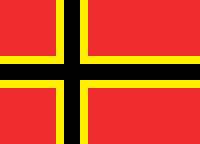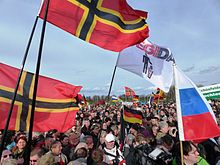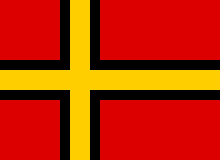Wirmer flag
| Wirmer flag | |
|---|---|
 |
|
| Vexillological symbol : |
|
| Aspect ratio: | 3: 5 |
| Officially accepted: | - |
The Wirmer flag (also known in trade as the German Resistance 20 July flag or the Stauffenberg flag ) is a design by Josef Wirmer , a resistance fighter of July 20, 1944 . According to his idea, it should become the new flag of Germany after the successful assassination attempt against Hitler and the transfer of power to the conspirators . Discarded as a federal flag by the Parliamentary Council in 1948/49, the draft, in a modified form, served the CDU from 1953 to around 1970 as a party flag and the FDP as a model for its party symbols. Then the Wirmer flag disappeared from the public eye.
In 1999, the pioneer of the neo-Nazi German College, Reinold Oberlercher , declared the flag in his revised draft constitution of November 9, 1999 as the flag of the Fourth Reich sought by the German College and was henceforth the flag of the German College. Horst Mahler , who published the proclamation of the Reich Citizens' Movement on December 14, 2003 , also belongs to the German college . As a result, the flag became popular in the Reich citizens' milieu , which at the time was neglected in the media and society, and was increasingly used by right-wing extremists and populist groups, which met with criticism from various sides. Because of its high presence at the Dresden Pegida demonstrations, the flag is also referred to as the “Pegida flag” in some media reports.
Emergence
Ottfried Neubecker's design
In the brochure Die Reichseinheitsflagge in 1926 the vexillologist Ottfried Neubecker proposed a flag in the color sequence black-gold-red as a compromise in the dispute over the German national flag. For this he made two suggestions: on the one hand a tricolor in this color sequence, on the other hand a red Philip's cross , bordered with gold, on a black background. This draft also circulated as a double stand as a proposal for a new Imperial War flag . It is believed that the Neubecker draft could have influenced Wirmer later.
Josef Wirmer's design
Like Neubecker, Josef Wirmer designed the flag named after him based on the Scandinavian cross flags . His favorite color sequence was created by trying out the three basic colors. In his opinion, the Christian cross was best suited as a symbol of the new state. After the assassination attempt on Adolf Hitler by Claus Schenk Graf von Stauffenberg , which Wirmer hoped to be successful, and the takeover of government by the civil resistance groups involved, the flag was to serve as the new national flag , since the black, red and gold tricolor of the Weimar Republic was not used wanted to take over. The colors were supposed to integrate the democratic forces, while the reference to the flags of the Scandinavian countries and the Christian symbolism should also appeal to the conservative circles among the officers, who hated the Weimar Republic with its flag. Incidentally, the Wirmer design eliminated the heraldic error in the color sequence of the tricolor. This violated the heraldic rule that between “colors” (here black and red) there must always be a “metal” (gold / yellow or silver / white). There is no evidence that Wirmer ever submitted his draft to the other conspirators. The failure of the attack and the seizure of power prevented the introduction of the flag. Josef Wirmer was arrested, sentenced to death and executed on September 8, 1944.
It is speculative that the structure of the “cross flag” was similar to that of the Reich war flag and that it should therefore also be accepted by the Wehrmacht . However, a report by Ernst Wirmer , Josef's younger brother, confirms this assumption. According to this, Josef Wirmer revised his design again and added a thin black line between gold and red, which corresponds to the Balkenkreuz of the German war flags. The second draft is wrongly attributed to Ernst Wirmer himself.
Later adaptations
Proposal as the national flag of the Federal Republic of Germany
After the Second World War , the constitutional convention on Herrenchiemsee , which met between 10 and 25 August 1948, also discussed the future national flag of the Federal Republic of Germany . The participants agreed on the national colors black, red and gold, but the shape of the national flag remained a point of contention. It was even emphasized that the choice of colors should not be equated with a return to the old tricolor of the Weimar Republic . The CDU, CSU and German party feared that this would lead to a “fateful flag dispute”. In addition, the SED had already envisaged the tricolor from 1919 as the flag of the GDR in its draft constitution of November 22, 1946 . Ernst Wirmer, now a member of the Parliamentary Council , persuaded the delegates of the Union parties and the German party to adopt his brother's second draft on October 16, 1948 and to propose it on November 5, while the SPD preferred the old tricolor of the Weimar Republic.
Wirmer's drafts were ultimately discarded and the CDU submitted another version of the “cross flag”. The draft for the legal text read: “The flag of the federal government shows a black horizontal cross on a red background and a gold cross placed on top of it.” In December 1948, the Allensbach Institute for Demoscopy asked around 1000 people in the three western zones about their preference for a national flag . The tricolor of the Weimar Republic received 35 percent of the votes, 15 percent were in favor of the "cross flag", 10 percent did not want either of the two proposals and 40 percent were undecided or disinterested. Theodor Heuss saw “graphic arts and crafts” and “artificialization” in the cross flag. In a poll in the Parliamentary Council, 25 percent of the members voted for a return to the black-red-gold tricolor in the tradition of the Weimar Republic, 35 percent had no opinion or abstained. The union application was rejected and the old tricolor was chosen by a large majority as the new federal flag .
Party flags from the CDU and FDP
At the party congress from April 18 to 22, 1953, the CDU adopted a cross flag as the party flag and coat of arms, based on the design by Josef Wirmer. This had no longer moved the cross to the leech in the Scandinavian style , but in the middle with horizontal arms of equal length. In addition, a centered golden eagle with a heraldic line of sight to the right spanned the motif. President of the Bundestag Hermann Ehlers interpreted the badge as follows:
“We see the eagle on it. It's the eagle of the old kingdom. We have no intention of having this eagle cut through in any way; it is the eagle of the whole of Germany! You see the cross on it. At this party congress, we will not stop for a moment from making it clear that the cross (...) as the defining symbol of the West is the content and power of our movement and work. You can see that this symbol has the colors black-red-gold. We want to make it clear that with this party congress we are very clearly committed to these colors and symbols of a new and an agreed German democracy. "
As a symbol, the Junge Union adopted a badge with a color sequence as in Neubecker's design: a red, gold-rimmed cross on a black background. Until 1962 the use can often be proven, then the cross symbol disappeared and was probably only used for cost reasons in local and district associations until the 1970s.
At its party congress in Bad Ems in 1952, the FDP also adopted a party flag derived from the Wirmer flag. Its gold, black-rimmed cross on a red background retained the Scandinavian shift. On the cross rested an eagle with the party initials and looking towards (heraldic) left. Its Saarland offshoot, the Saar Democratic Party (DPS), reversed the eagle's line of sight to (heraldically) right. There is speculation about whether the heraldically wrong line of sight of the FDP eagle is a legacy of former NSDAP functionaries , many of whom were part of the young party. The NSDAP eagle also looked to the left - on the grounds that the East was the geographical goal of the “movement”. The DPS justified the view to the right with the representation of the " Watch on the Rhine " to the west.
With the end of its use as a party symbol, the various cross flags in black, red and gold disappeared from everyday life. The Wirmer flag remained known in the circles of vexillologists and appears in relevant publications. In 1981, for example, the political scientist Theodor Eschenburg asked Ernst Wirmer about his brother's flag designs. In the East Prussian Gazette of October 31, 1987, the Wirmer flag and its history by Harry S. Schurdel was dealt with in the series "German National Flags".
Use by right-wing extremist and right-wing populist groups

In 1999, Reinhold Oberlercher, as a pioneer of the neo-Nazi German College , to which the right-wing extremists Horst Mahler and Uwe Meenen belong, proclaimed the Wirmer flag as the possible national flag of the “ Fourth Reich ” they were striving for . Horst Mahler, who proclaimed his Reich Citizenship Movement on December 14, 2003, spread the flag in the Reich citizen milieu. Since then, the Wirmer flag has appeared more and more frequently in Germany at events organized by right-wing extremist and right-wing populist groups, such as the German Defense League , Hogesa , pro NRW and numerous times at the weekly Pegida demonstrations in Dresden, as a "neo-conservative battle symbol". There are no legal restrictions with the Wirmer flag - unlike the similarly acting Reich War Flag, which even in the version without a swastika can be seized by the police for "violation of public order". On the blog Politically Incorrect (PI), classified by the Bavarian Ministry of the Interior as extremist and unconstitutional , the flag is seen as a symbol against alleged foreign rule. The Scandinavian cross is a "commitment to Nordic cultural tradition" and the "response of the resistance fighters to an unchristian state". Sections of the New Right see the flag as a symbol of "Secret Germany".
In the world, Sven Felix Kellerhoff called the use of the flag by right-wing populists a “misjudgment”, based “on fundamental historical ignorance”. Josef Wirmer's son Anton was “horrified”. It is basically the distortion of all the ideas that his father's flag represents. It is important to “clarify the origin of the flag and what ideas were connected with it. The Wirmer flag does not represent an abstract concept of resistance. Above all, it stands for a liberal and tolerant society. "The Frankfurter Allgemeine Zeitung quotes Robert von Steinau-Steinrück, chairman of the foundation on July 20, 1944 , with the assessment that waving the Wirmer flag at extremist and xenophobic events mocked that, what Josef Wirmer stood for: a free and tolerant society. Jan Schlürmann writes in his article for the Konrad-Adenauer-Stiftung about the Wirmer flag that there is a “expropriation of a venerable and traditional symbol of Christian democracy”.
literature
- Arnold Rabbow: A Flag Against Hitler. The 1944 National Flag Proposal of the German Resistance Movement , in: The Flag Bulletin, XXII: 3-4, No. 100 (May-August 1983), Ottfried Neubecker Festschrift, edited by the Flag Research Center, Winchester (Massachusetts), ISSN 0015-3370, pp. 167-181.
- Arnold Rabbow: Christian Democratic Union , in: dtv-Lexikon political symbols, Munich: 1970, pp. 53–54.
- Arnold Rabbow: Visual symbols as an appearance of non-verbal journalism (= work from the Institute for Journalism at the University of Münster; Vol. 3), Münster: 1968, zugl. Phil. Diss., Pp. 267–291.
-
Jan Schlürmann : The "Wirmer Flag" - the changeful history of a forgotten symbol of German Christian democracy , in: Historisch-Politische Mitteilungen. Archive for Christian Democratic Politics 22 (2015), pp. 331–342.
- The Wirmer flag, its precursors and derivatives 1926 / 44–2015 (two color tables added later to the article).
Web links
- Flags of the World : Josef Wirmer's “Resistance Flag” proposal 1944
- Flags of the World: Free Democratic Party: Flags in the 1950s (Germany)
Individual evidence
- ↑ a b Christina Hebel: Pegida and the Wirmer flag: "I'm horrified" . In: Spiegel Online , August 3, 2015. Accessed October 19, 2015.
- ↑ Tagesspiegel: Why the AfD is not a conservative party , September 9, 2016 , accessed on March 15, 2018.
- ↑ Andreas Speit (ed.): Reich Citizens. The underestimated danger , Berlin 2017, p. 24.
- ↑ The flag - blow!
- ↑ https://web.archive.org/web/20040602233745/www.aufstand-fuer-die-wahrheit.net/reichsbuergerbewegung.html
- ↑ Wirmer flag Pegida and the symbol of the Hitler attackers , Süddeutsche Zeitung , August 3, 2015
- ^ History Black-Red-Gold Pegida assumes the legacy of July 20 , by Sven Felix Kellerhoff, Die Welt January 20, 2015
- ↑ Symbolism in demos Why the flag of the cross flies at Pegida , by Christina Hebel, Der Spiegel July 29, 2015
- ^ A right riddle , Der Spiegel February 20, 2016
- ^ " An eye for an eye" MDR cuts Pegida flag from Dresden - "Tatort" , Mitteldeutsche Zeitung October 26, 2017
- ↑ Breakdown at the MDR Because Pegida supporters appear: Dresden “Tatort” has to be cut. Focus October 27, 2017
- ^ Arnold Rabbow: Ottfried Neubecker turns 100 . flaggenkunde.de, March 22, 2008. Retrieved November 3, 2015.
- ↑ Jan Schlürmann 2015, pp. 333–334.
- ↑ Proposals for a German national flag 1919-1933 (page 5) - Perhaps the work of Ottfried Neubecker . In: Flags of the World , accessed November 3, 2015.
- ↑ Jan Schlürmann 2015, p. 334.
- ↑ a b c d Jan Schlürmann 2015, p. 337.
- ↑ Josef Wirmer's "Resistance Flag" proposal 1944 . In: Flags of the World, accessed October 19, 2015.
- ↑ a b Jan Schlürmann 2015, p. 338.
- ^ Federal Agency for Civic Education: Ernst Wirmer (CDU) . Retrieved September 10, 2016.
- ↑ Flagmaster . In: The Flag Institute Bulletin , No. 77, 1994, pp. 8/9.
- ^ Peter Reichel : Black - Red - Gold. A short history of German national symbols after 1945. CH Beck, Munich 2005, ISBN 3-406-53514-3 .
- ↑ a b Sven Felix Kellerhoff: Pegida assumes the legacy of July 20th . In: Die Welt , January 20, 2015. Retrieved October 19, 2015.
- ↑ CDU party congress. Great moment of mankind . In: Der Spiegel , April 29, 1953. Retrieved October 21, 2015.
- ↑ Jan Schlürmann 2015, pp. 339–340.
- ↑ Jan Schlürmann 2015, p. 340.
- ^ Christian Democratic Union 1953 – c1970 (Germany) . In: Flags of the World, accessed October 19, 2015.
- ↑ Jan Schlürmann 2015, pp. 340–341.
- ↑ Jan Schlürmann 2015, p. 341.
- ↑ Harry D. Schurdel: “Symbol of the idea of freedom. The historical development of colors in Germany ", Part V of the series" German National Flags "in the Ostpreußenblatt of October 31, 1987, p. 10. online edition (PDF, 13.5 MB)
- ↑ a b c Jan Schlürmann 2015, p. 342.
- ↑ Christina Hebel: Symbolism in demos: Why the cross flag flies at Pegida . In: Spiegel Online , July 29, 2015.
- ↑ a b Pegida and the symbol of the Hitler assassin . In: Süddeutsche Zeitung , August 3, 2015. Retrieved October 19, 2015.
- ^ Carsten Stoffel: Solingen: ProNRW and the mysterious flag . In: Solinger Bote , accessed on October 19, 2015.
- ↑ Prohibited symbols of right-wing extremist organizations (PDF). Protection of the Constitution of Brandenburg , accessed on October 22, 2015.
- ↑ “Die Freiheit” and PI are considered unconstitutional in Bavaria . In: Süddeutsche Zeitung , April 12, 2013. Retrieved October 26, 2015.
- ↑ Service: What kind of flag with a cross is that at Pegida and Co.? In: Netz gegen Nazis , January 12, 2015. Retrieved October 19, 2015.
- ↑ Christina Hebel: Symbolism in demos: Why the cross flag flies at Pegida . In: Spiegel Online , July 29, 2015.
- ↑ Matthias Gafke: How right-wing populists stylize themselves into resistance fighters In: FAZ , September 7, 2016, accessed on September 7, 2016.




